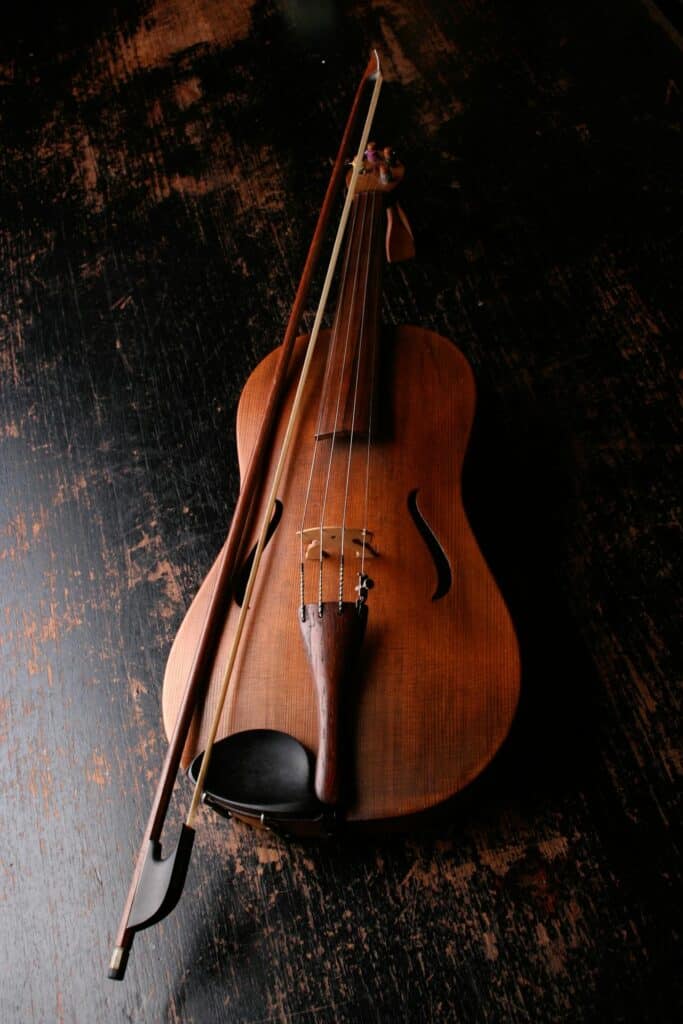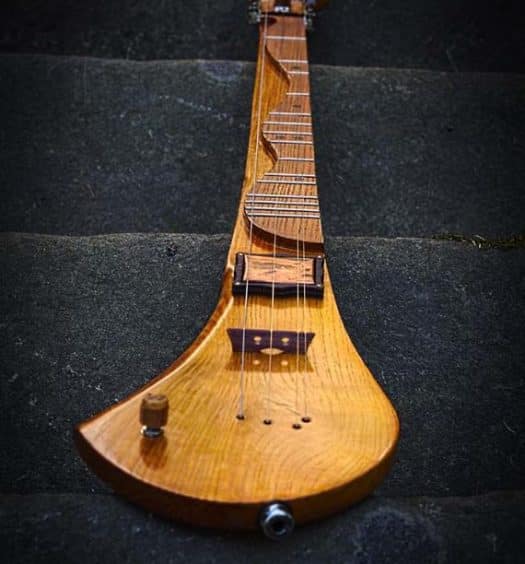The dulcimer and violin are both unique and popular stringed instruments. While they share some similarities, they differ in many ways. These include overall structure, sound, playing technique, musical genres, and cultural significance.
In this article, we’ll take a quick look at the dulcimer vs. violin and their key differences.
Construction
The mountain dulcimer is a stringed instrument with a distinctive shape and structure. It has a flat, elongated body with a fretboard that is either diatonic or chromatic. The body is often made from woods like spruce, maple, or walnut, with a sound hole in the center for resonance.
Mountain dulcimers usually feature 3 or 4 strings, which are plucked or strummed with a pick or fingers. Traditionally, a noter can be used as well.
The violin, however, has a more intricate structure than the dulcimer. It has a smaller, curved body, and is played with a bow that is drawn across four strings. In addition, it includes fine tuners, chin rest, and a shoulder rest.
Like the dulcimer, the violin’s body is typically made from fine woods like spruce (top) and maple (back, sides, and neck).

Sound and Tone
The sound of a dulcimer is often described as warm and peaceful. It has a mellow tone due to its flat body and typically fewer strings. The tone can vary, however, depending on how the it’s constructed and played. But in general, the dulcimer lacks the sharpness and brightness of other stringed instruments like the violin.
The violin, on the other hand, produces a much brighter and more complex sound. The ability to vary pitch, tone, and vibrato with the bow makes the violin highly expressive. It has a more penetrating sound, and is able to cut through orchestras where the dulcimer may get lost without amplification.
Playing Technique
When in comes to the dulcimer vs guitar, there are many notable differences in terms of playing technique.
Playing the dulcimer involves either plucking or strumming the strings, often using a pick or sometimes fingers. Dulcimer players often rest the instrument on their lap while playing, although a small table works as well. The strings are pressed down on the frets to change the pitch, and a noter is traditionally used.
The technique is actually much simpler than that of the violin. Beginners can quickly pick up basic melodies, as the diatonic fretboard makes it easy to learn certain scales.
In contrast, playing the violin is more technically demanding. The player uses a bow to create friction with the strings, which produces sound through a combination of speed and pressure. Mastering bow control is crucial for achieving smooth, consistent sound and requires years of practice.
Unlike the dulcimer, the violin has no frets – requiring yet another level of attention to achieve the desired pitch.
Learn More >> Dulcimer vs. Mandolin
Accessibility and Learning
When comparing the dulcimer vs violin, the dulcimer is generally a more accessible instrument for beginners. This is largely because its design is less complex, and its playing technique is easier to pick up. It’s great for those who want to start playing music quickly without a steep learning curve.
In addition, the diatonic fretboard helps players avoid difficult finger placements. This makes it easier to produce pleasing melodies even with minimal experience.
In contrast, learning the violin takes time to master. The absence of frets means that violinists must develop a fine sense of pitch. And as discussed, mastery of bowing techniques is critical. The ability to play in tune is a skill that can take years to develop.
Musical Styles and Repertoire
In terms of musical style and repertoire, there are distinct differences when comparing the dulcimer vs violin.
The dulcimer is commonly associated with folk and traditional music, particularly in the Appalachian region of the United States. It has a unique sound that lends itself well to playing traditional tunes and creating a melodic and rhythmic foundation.
The dulcimer has also been adapted to contemporary genres, including folk-rock and world music. Joni Mitchell, for example, was quite fond of the dulcimer. It played a key role in her critically acclaimed album Blue.
The violin, on the other hand, has a far more expansive role in music across cultures. The violin has a vast repertoire and is used in various musical styles. It is an essential instrument in classical music and also plays an important role in jazz, folk, and even contemporary music.
Tuning
When comparing the dulcimer vs violin, there are also distinct differences in terms of tuning.
The dulcimer often uses specific tunings based on the particular variation being played. For example, the mountain dulcimer is typically tuned to D-A-D or D-A-A, while the hammered dulcimer can have different tunings depending on the goal of the musician. These tunings contribute to the unique sound and characteristic drone effect of the dulcimer.
The violin, however, is traditionally tuned to G, D, A, and E and is played with a bow that is drawn across these four strings.
Summary
Both the dulcimer and violin are stringed instruments that produce beautiful music. However, they are fundamentally different in their design, sound, playing techniques, and cultural contexts.
The dulcimer is known for its mellow (or dulcet) tones and beginner-friendly nature. It appeals to many, particularly in the folk and Celtic genres. In contrast, the violin has a more rich history in classical, folk, and even jazz music. It requires more dedication and technical skill, but offers unparalleled versatility and expression.
Interested in learning the difference between a dulcimer and other instruments? Check out our quick comparisons with the guitar, lute, or zither.




